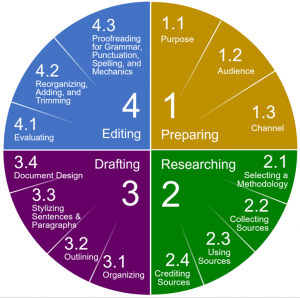Chapter 4: The Writing Process III: Drafting
When you learn a mnemonic (memorization helper) like MAPS, each of the parts seems very distinct: message, audience, purpose, style. Remember, however, that separating the parts this clearly this is mainly useful as a learning strategy.
In reality, any choice you make about one of these elements will affect how you think about the other elements. When you’re actually doing the drafting, the process can be messy. Sometimes, you start with a sketchy idea of what you feel or what you need to say (message). However, once you think about who you’re dealing with (audience), that might make you reconsider the details of your message and should influence how you think you should communicate (style). Overall, any choice around message, audience, purpose, and style might require you to go back and modify your message until the elements are balanced and consistent with each other.
Imagine this: what if you were asked to describe the best night of your life? What is the first image or idea that comes to mind? How would you describe it or represent it? How might that message change if you realized your answer would be shared with your mom? (audience). How might it look different on the page if you knew your answer would be used in an application for your dream job? (purpose and style).
Remember, too, that your process doesn’t need to follow MAPS in that exact order of figuring out “message first, audience second, purpose third, and style last.” Sometimes, your process will go in sequence of SPAM. Other times, it might be AMPS or ASPM. For example, if your professor assigns an essay or your boss demands a report, audience might be your starting point. You know who you’re writing for, but you want to figure out what they expect before you start tackling the job. If your audience requires a specific style of communication, such as a formal academic essay or investigative report, you might need to learn more about style, what these documents look like. Only then might you get into researching the topic itself so you can get to work drafting and delivering the message.
This section offers a few ways of thinking about how to organize your message and make choices around style. In a traditional writing process, these processes fit into section 3 (the purple part of the circle in the chart below):
Figure 4: The four-stage writing process. Topics around organization and drafting are in Section 3 (the purple section).


